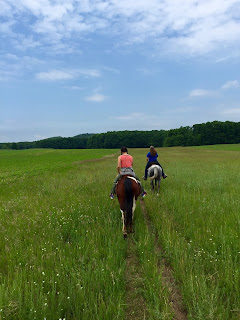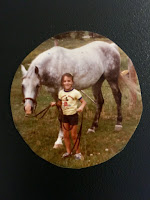Learning to Ride
At the age of 6, my dad allowed me to ride my first horse in
Roundup, Montana. This old gentle grey Appaloosa graciously accepted my unbound
enthusiasm and newfound confidence. Since that day, I’ve had a meaningful connection
to and appreciation for horses. While growing up, I spent a great deal of time riding,
caring for, and learning from them.
This particular photo of me inspired me to reflect upon the interconnectivity among our lived experiences, learning, leading, and succeeding.
This particular photo of me inspired me to reflect upon the interconnectivity among our lived experiences, learning, leading, and succeeding.
Getting Back on the Horse
When I was 10 years old, I rode Sammy down our dirt road to the
neighbor’s home which was about a mile away. Sammy was a very young horse and only
green broke – he was just beginning to be able to accept riders on his back. My
dad was coaching me carefully as he rode next to me, as green broke horses can
be jumpy and unpredictable. Sammy did great! Until…
The neighbor’s dog (old ornery dog named Keen!) nipped at
Sammy’s back heels, which caused him to immediately shoot straight into the air
on all fours, then proceed into a running and bucking frenzy. After about three
jumps, I fell off and landed pretty hard on my right elbow. I was probably more
scared than hurt at that point. Despite the tears and having the wind knocked
out of me, my dad taught me an incredibly valuable leadership lesson through five simple
words – “get back on the horse.”
In the Saddle Again
It was a wonderful character building moment for me –
learning the discipline of accepting and pushing through painful, difficult, ambiguous,
or stressful times. This core characteristic served me well in the military, throughout
my career, and in the face of personal adversity.
As a rider, it was also my obligation to teach the horse a lesson. His bad behavior was given no special attention - he was not rewarded. In addition, I showed him I was not afraid of him (horses are keenly aware of fear and will use it to misbehave).
Scanning Your Environment
One of the most fundamental skills of riding a horse is staying
alert and paying attention to the overall environment. Is it windy? Are storm
clouds forming? Are there other animals around? What are the horse’s ears
telling you? That’s right! His ear positioning provides valuable intel about
the environment. Each unique position tells you if he is relaxed, sees
something, hears a noise, or is getting ready to misbehave (e.g. bite another
horse, buck, or kick).
Continuously scanning your environment keeps you safe and
thriving. The same is true for industry. Market scanning is continuously analyzing
the external market to gain critical insights about the following:
- Market needs and new market opportunities
- What your competitors are doing
- Proactive strategies
- Value-added technology and innovation
Businesses and organizations should pay close attention to
external forces, and should look to other industries for insights, ideas, and
strategies. In higher education, institutions gravitate towards other institutions
with a similar size, scope, and mission for insights, learning, and bench marking.
Imagine the possibilities if institutions put more effort into learning from
institutions different from their own, or from the business, healthcare or
government sectors.
Diversity of thought
and perspective sparks creativity, momentum, and success.
Leading With Humor
When you think of a horse what’s the first thing that comes
to mind? Perhaps it’s strength, endurance, or unbridled freedom. Did you know
they have an intrinsic sense of humor? They find ways, sometimes mischievous
ways, to intentionally draw their riders and caregivers into their humor.
Do you find ways to effectively draw others in through the
use of humor in the workplace? Effective use of humor can relieve stress, improve
morale, change the tone of the entire room, and spur creativity. Of course, the
right setting, timing, cadence, and delivery matters. It takes practice. When
you find others who use humor well, pay attention to the contextual details so
you can sharpen your skills.
 Happy Trails
Happy Trails
Know that your toes are going to get stepped on at some
point. You may fall down or get kicked around. Your ego may get bruised. Yet
this fact remains true: we are in control because we have the freedom to choose
how we respond. One way to build resiliency is to find the things, activities, and
people who bring us the greatest joy. Place a renewed focus upon these.
Trail riding is one of the most calming and uplifting experiences. Give it a try! You come away feeling peaceful, and closely connected to the horse and mother earth.
Happy trails to you now and always.
Trail riding is one of the most calming and uplifting experiences. Give it a try! You come away feeling peaceful, and closely connected to the horse and mother earth.
Happy trails to you now and always.





Comments
Post a Comment